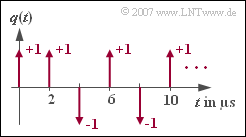Exercise 1.1Z: Non-redundant Binary Source
Any digital source can be completely described by its source symbol sequence
- $$\langle q_\nu \rangle = \langle \hspace{0.05cm}q_0 \hspace{0.05cm}, q_1 \hspace{0.05cm}, q_2 \hspace{0.05cm}, ... \hspace{0.05cm} \rangle.$$
Contrary to the theory part, here the control variable $\nu$ starts with zero. If each individual symbol $q_\nu$ originates from the symbol set $\{\rm L, \ H\}$, it is called a binary source.
Using the symbol spacing $T$, one can also characterize the source symbol sequence $\langle q_\nu \rangle$ in an equivalent way by the Dirac-shaped source signal
- $$q(t) = \sum_{(\nu)} a_\nu \cdot {\rm \delta} ( t - \nu \cdot T),$$
which rather corresponds to a system-theoretic approach. Here, we denote $a_\nu$ as the amplitude coefficients.
- In the case of a binary unipolar digital signal transmission holds:
- $$a_\nu = \left\{ \begin{array}{c} 1 \\ 0 \\ \end{array} \right.\quad \begin{array}{*{1}c} {\rm{for}} \\ {\rm{for}} \\ \end{array}\begin{array}{*{20}c} q_\nu = \mathbf{H} \hspace{0.05cm}, \\ q_\nu = \mathbf{L} \hspace{0.05cm}. \\ \end{array}$$
- Correspondingly, in the case of a bipolar system:
- $$a_\nu = \left\{ \begin{array}{c} +1 \\ -1 \\ \end{array} \right.\quad \begin{array}{*{1}c} {\rm{for}} \\ {\rm{for}} \\ \end{array}\begin{array}{*{20}c} q_\nu = \mathbf{H} \hspace{0.05cm}, \\ q_\nu = \mathbf{L} \hspace{0.05cm}. \\ \end{array}$$
The diagram shows the Dirac-shaped source signal $q(t)$ of a binary source. It is known from this source that it is redundancy-free. This statement is quite relevant for solving the problems.
Notes:
- The exercise belongs to the chapter "System Components of a Baseband Transmission System".
- Reference is made in particular to the section "Descriptive variables of the digital source".
- In the literature, the two possible binary symbols are usually designated as $\rm L$ and $\rm 0$.
- To avoid the somewhat confusing mapping $a_\nu = 1$ for $q_\nu =\rm 0$ and $a_\nu = 0$ for $q_\nu =\rm L$, we use the symbols $\rm L$ ("Low") and $\rm H$ ("High") in our learning tutorial.
Questions
Solution
(2) With this redundancy-free binary source – and only with such a source – the bit rate is $R = 1/T\hspace{0.15cm}\underline{=500 \ \rm kbit/s}$.
(3) The possible amplitude coefficients are $\pm 1$. Therefore, the given symbol sequence is bipolar.
(4) The amplitude coefficient $a_2$ can be read at $2T = 4 \ \rm µ s$. With bipolar mapping, it follows that $a_2 = -1$ for symbol $q_2 \hspace{0.15cm}\underline {=\rm L}$.
(5) Even if the diagram suggests otherwise for the short time interval shown here: For a redundancy-free binary source, in addition to the statistical independence of the symbols, $p_{\rm H} = p_{\rm L}\hspace{0.15cm}\underline{ = 0.5}$ (equally probable symbols) must also hold.
